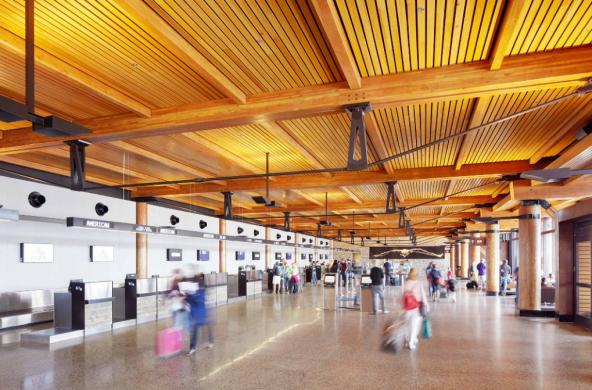Home > Case Studies > Putting the People First, Using Wood to Build a Healthy Environment
PUTTING THE PEOPLE FIRST, USING WOOD TO BUILD A HEALTHY ENVIRONMENT
The American Hardwood Export Council (AHEC) Southeast Asia & Greater China, held a seminar on American hardwood sustainability with the theme of “Environment, Design and Hardwood” together with the USDA Foreign Agricultural Service and the Asian chapter of the American Institute of Architects (AIA) at the Columbia University Global Center in Beijing. Emma Zhang, vice president and director of design at Gensler, was invited to deliver a keynote speech on sustainable design that analyzed contemporary health-based designs built from the environmentally friendly American hardwood.
Emma Zhang joined Gensler in 2003 and has worked in the United States, Shanghai and Beijing branches, giving her an in-depth understanding of the industry in both China and the United States. She’s participated in many timeless projects like the 2014 APEC Summit, the China Red Sandalwood Museum and Tencent’s Shenzhen headquarters. Her fields of expertise cover commercial properties, residences, offices, government buildings, and science & technology. On top of being exceptional at designing and solving problems in many large complex projects, she also has a profound background and rich leadership experience in overall planning and design fields like architectural design, interior design and sustainable design.
Don’t design for design
Emma Zhang once said to new designers that “being a designer is a spiritual profession, like a belief.” She believes that, “you can’t design for design.” Some customers request a replication of previous projects out of sheer admiration but Emma guides these customers to determine a more suitable design according to their own needs, tied in with a bit of company culture.
“Although there are trends in the field of design, I don’t advocate for them,” said Emma. “Trends are not always the most suitable design; it’s easy to lose sight of important factors by blindly following trends.” Even if the trend is extremely popular and she favors the design, Emma remains objective in her evaluation.
Many famous American hardwood loving designers have their own preferred species of wood, sometimes it’s because of an easy-to-build texture, sometimes it’s a special color. Emma, however, loves all kinds of wood. “I like all types of wood because each species has their own unique characteristics. When selecting materials, I consider the overall context. For example, elderly oriental like cherry, oak and woods that give off a sense of stability and reliability while the younger generation prefer lighter color shades and grey-colored wood. Cultural settings shouldn’t be ignored either, if the design is for a Japanese restaurant, I tend to use black and white colors which are more desirable in Japanese culture,” she explains.
Beyond sustainability and building a healthy environment
In addition to its eco-friendly attributes, Emma discovered that American hardwood is also beneficial for physical and mental health. In her speech, her discussions on sustainability often involved health impacts because she believes “a healthy body depends not only on heredity, diet, exercise and overall well-being, but also on the indoor environments we are exposed to every day.”
“According to studies, wood brings a greater sense of security than concrete and steel. Close contact with wood naturally raises intimacy and stimulates feelings of relaxation and warmth, leading to a greater release of endorphins. These positive feelings relieve stress, elevates mood and contributes to our physical and mental health,” shared Emma. On top of these merits, Emma always adds elements to the design that promotes physical activity, rather than sedentary behavior.
In recent years, American hardwood has become a powerful voice for sustainability. Not only because wood is a naturally occurring material, but also due to its low-carbon processing and its renewable features. Emma admits that she was shocked when AHEC shared their data on American hardwood growth. She never thought that wood was so universally loved and that growth was so high, designers will now be able to decorate every corner of the world with wood.
Introduction of Gensler classic cases:
The “HRT” at the front desk of the Hudson River Trading office in New York, USA, is made of American Oak.


Jackson Hole Airport in U.S.


888 Brannan Street renovation project in San Francisco, USA

Yeti headquarters in Austin, USA


About American Hardwood Export Council (AHEC)
The American Hardwood Export Council (AHEC), headquartered in Washington DC, USA, is the leading international trade association for the US hardwood industry. AHEC represents the committed exporters among US hardwood companies and all major US hardwood production trade associations. Concentrating on providing architects, designers, traders, processors and end-users with technical information on the range of species, products and sources supply.
The American Hardwood Export Council (AHEC) Southeast Asia and Greater China (SEA & GRCH) office was opened in Hong Kong in 1992 to serve and oversee nine Asian markets including Mainland China, Taiwan, Hong Kong, Singapore, Malaysia, Thailand, Indonesia, Philippines and Vietnam.
For more details, please visit the AHEC Southeast Asia & Greater China website:
www.ahec-china.org
